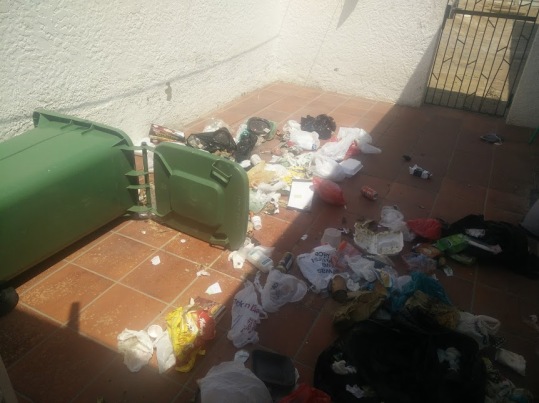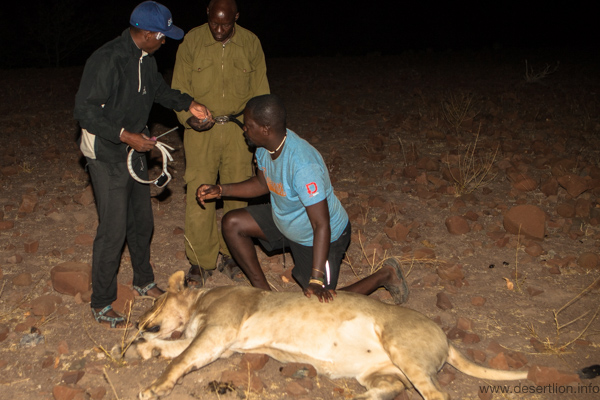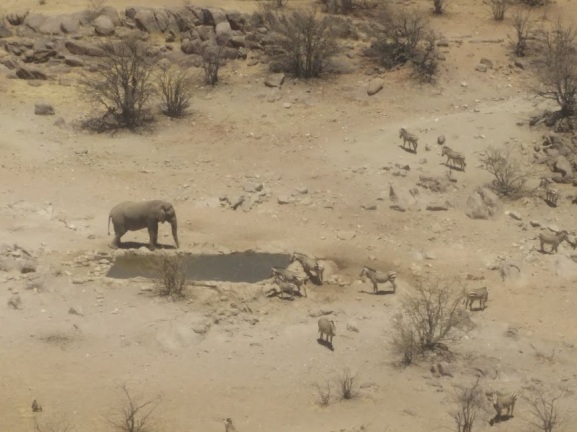Namibia, a land that boasts of remarkable nature and its unique culture has always fascinated me. As a kid, it has always been a dream of mine to see the wildlife in southern Africa. I recently had the opportunity to visit this beautiful country that is also home to a wealth of indigenous cultures. The flight from Munich to the capital of Namibia, Windhoek, was achingly long but the buzz inside me to land in Namibia made time go fast. I got out of the flight with a chilly breeze on my face. Partially covered by the Namib Desert, one of the world’s driest deserts, Namibia’s climate is generally very dry and pleasant with temperatures during the day averaging 30-35° C, and as low as 0-5°C at nights.
“Only when the last of the animals horns, tusks, skin and bones have been sold, will mankind realize that money can never buy back our wildlife” ―
I wasn’t sure if I was excited or nervous while waiting for the security check at the airport that was seemingly small for a country’s capital. After all, it was my first time in Africa. Windhoek, located in the central highlands, is the largest and most populated in Namibia with about 325,000 residents. This is relative, considering that the whole country has only a population of approximately 2.5 million, which is about 1/8th of the population of Mumbai. I couldn’t help but smile when I came across people who felt that Windhoek was too crowded with a fast-moving life. After exchanging euros to Namibian dollars, I took a taxi to the city that was 40kms away.
Both sides of the road were occupied by distant mountains and vast empty drylands with shrubs and bushes. On my way, I came across the first wildlife, baboons sitting on both sides of the road and searching for something on the grass. Upon talking to the taxi driver, he explained how severe droughts over the past years have drawn some animals, particularly baboons, closer to the city in search of food.

Photo: Baboons leaving me to do all the work at my apartment in Windhoek
The influence Germany had in Namibia during the colonial days could be seen on the infrastructure and on the street names in Namibia. A few days into my stay in Windhoek, I started realizing how most of Namibia’s food culture revolved around meat. This included game meat like springboks and zebras. This is understandable, given that Namibia is a dry country and agriculture in such conditions isn’t possible. After my meetings with the Deputy Director of Wildlife Research and Monitoring at the Ministry of Environment and Tourism, I decided to visit the coastal city of Swakopmund. Established by the German colonists in 1892, Swakop is the epitome of Germany’s culture influence in Namibia. There are a lot of adventure sports around Swakop and the popular movie scenes (particularly Indian movies) where the desert merges with the sea is probably taken not too far from Swakop. Quad biking on the Namibian dunes was a new and adrenaline filled experience even though I floundered quite a few times in between.

Photo: Quad-biking among the Namibian dunes
From Swakop, I left to the north of Namibia, where I was fortunate enough to be a part of the meeting on “Early Warning Systems for lion-human conflicts in north-west Namibia”. The meeting included officials from Namibian Ministry of Environment and Tourism, Integrated Rural Development and Nature Conservation (IRDNC), Desert Lion Conservation, AfriCat North, WWF-Namibia and University of Minnesota Lion Center. The meeting was fruitful, and I got to meet Dr. Philip Stander, the founder of Desert Lion Conservation, with whom I was to spend the next 5 days. Philip, also known by the name of ‘Flip’, has been working on desert lions for more than 25 years. I also got the opportunity to meet Tammy, the director of AfriCat. She heads the research group called AfriCat North, focusing more on the lion-human conflict mitigation in the region.
I left with Philip and his team of lion rangers to Anabeb Conservancy that is located on the north-west of Namibia. Philip is a pioneer on desert lions and has worked on lions pretty much his whole life. Few years back, I would’ve never thought that I would actually get to meet him and discuss potential projects with him. But there I was, being on the field with him and his team. Camping in the open lands of Namibia was a new experience for me. We set up our camping tents a couple of kilometres from where Philip wanted to radio-collar a group of lions that he hasn’t had the chance to study in detail before. The nearest grocery store was maybe 35-40kms away, so we had to be prepared with the groceries beforehand. On most occasions, it was just porridge and occasionally some prepared food from a community of pastoralists that lived nearby. Nights were chilly, and of course no electricity, so firewood was essential. The nights were beautiful, the clear skies in Namibia with a million stars are a sight to see.

Photo: Camping site in Anabeb Conservancy
Lions are most active at night, so Philip had to spend hours setting himself up before sunset just waiting for the lions. We knew the lions were around because we saw carcasses of a zebra that was killed by the lion pride on the night before at a water spring nearby, and the lion rangers found fresh lion tracks. The first two nights were unsuccessful, but on the third night, around 11pm, we got a radio message from Philip that he darted two adult lionesses. We followed the beam light from Philip’s van, and got to Philip quite quickly. The lionesses were in their primes, very well built and in good condition. That was the first time I was seeing a lion out in the wild, and it was magnificent being able to be next to one. The lionesses were under anesthesia for about 40 minutes, so Philip had to quickly fit the radio collars and take measurements.

Photo: Lion rangers from Desert Lion Conservation fitting radio-collars
Philip knew that this pride consisted of probably 4 or 5 lions, so we decided to wait a couple more days to collar the remaining adult lions in the group if possible. It seemed like we hit a jackpot when we got a message from Philip telling that he darted two more lions around 12am on the 4th day. We quickly went to the spot, and two sub-adult lions, one male and a female. A bait had been kept by Philip that attracted them. Philip mentioned that its critical to keep track of sub-adults because if they get in contact with livestock, then they would get habituated to it easily, and would become problem animals in the future. He decided to fit radio collar on one of the sub-adults as they were still growing. The trip turned out to be very successful as I got to discuss my plans in detail with Philip and we decided to work on understanding genetic diversity, movement patterns and lion-human conflicts of the desert lions and potentially brown hyenas.
After a short break in Windhoek, I left to meet Ms. Tammy Hoth-Hanssen, the director of AfriCat, an organization that’s committed to the long-term conservation of Namibia’s carnivores since 1991. I met her and her team at their base camp in north, near the very famous Etosha National Park. AfriCat North primarily does research on a group of lions in the region with the main aim to mitigate conflicts as the area has large number of settlers with livestock.

Photo: Scott from AfriCat North trying to locate the collared lions
I spent two days, with Scott, one of the main lion rangers from her team. There was information that a pride of lions left the concession area (an area that’s like a national park, but not fenced), into the conservancy area where the villagers live. This was a problem because as long as the lions were inside the concession area, they were safe. But the lions had killed one of the farmer’s livestock, and we had to make sure the pride was back inside the concession area to avoid further conflict. After much tracking, we saw their tracks that saw them returning into the concession. Scott tracked them, and we came across one of the male adults resting under a tree. I also got to see elephants, and giraffes, oryx and kudus in between. Zebras, springboks and baboons were relatively easier to spot.

Photo: Elephants and zebras at the waterhole on a scorching day
I returned to Windhoek for my last weekend after my time at AfriCat North. I spent time at some of the city’s museums, street markets and explored some off-beat cafes and bars. Namibians are a very welcoming folk, they were always a tad bit curious about India and its traditions and are huge followers of Indian films and TV shows. I made some good friends on the way and got to spent time with some interesting fellow travellers. After more than a month in Namibia, it was time for me to return to Munich but with enduring memories and in hope that I would be back to Namibia very soon to work on the fascinating desert lions and brown hyenas.
Really interesting Vishnu…
LikeLike
Thank you uncle.
LikeLike
Interesting and amazing. Keep it up!
LikeLike
Thanks Varsha!
LikeLike
Excellent..All the best..Keep posting such experience..
LikeLike
Very well written Vishnu
LikeLike
Thanks Arun!
LikeLike
Excellent Vishnu. Keep it up!
LikeLike
Thank you 🙂
LikeLike
Well done man. Good read 🙂
LikeLike
Thanks Rishi 🙂
LikeLike